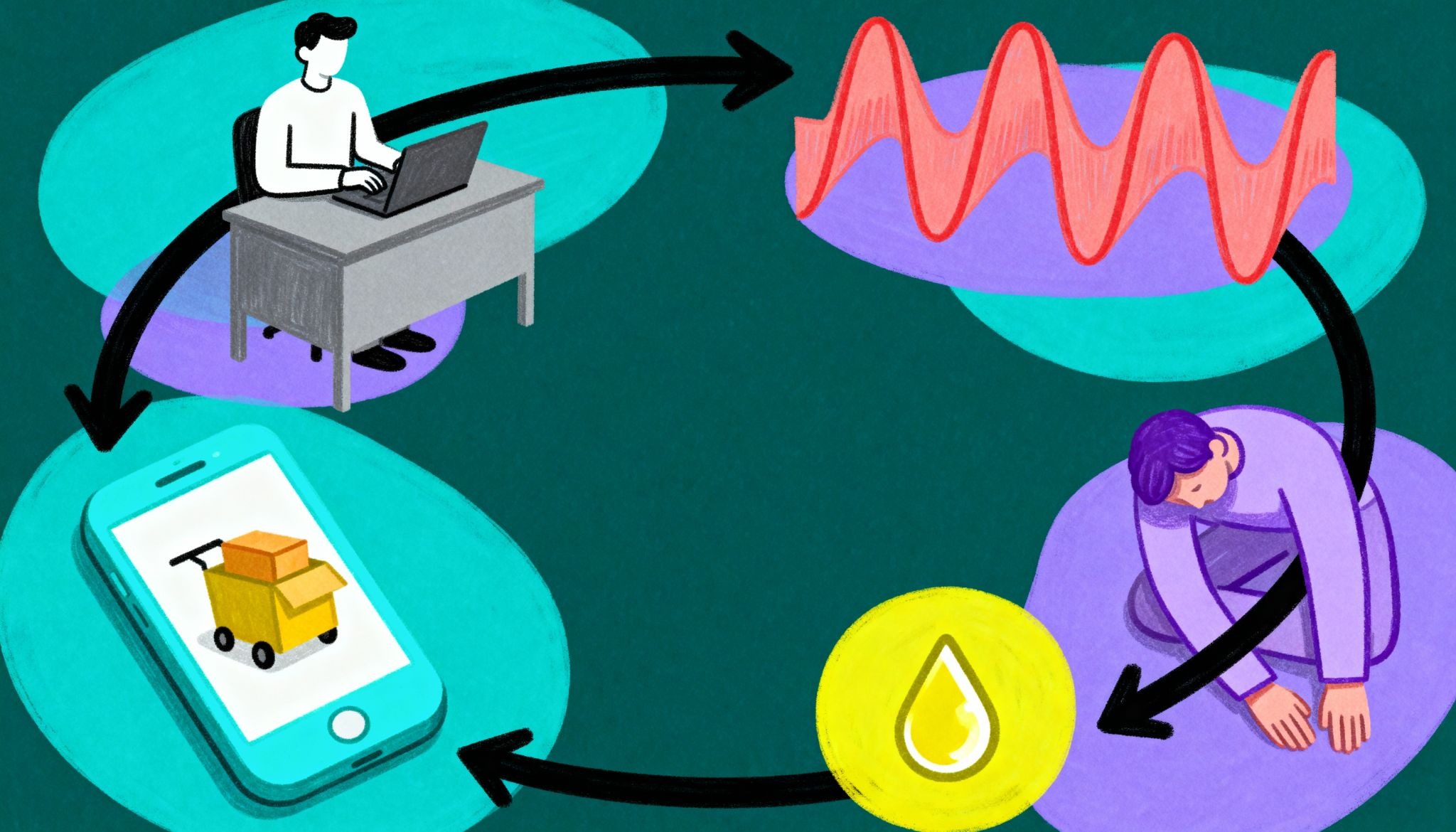
Riya was 32 when her doctor said the word "diabetes."
Not prediabetes. Not "borderline." Full Type 2 diabetes.
She remembers thinking: This is something that happens to my parents' generation. Not mine.
She was working 60-hour weeks at a Bangalore tech firm. Breakfast was usually skipped. Lunch was Swiggy. Dinner was whatever arrived fastest at 10 PM. Exercise was "something I'll start next month."
Her story isn't unusual anymore. It's becoming the norm.
{{divider}}
Loop's Workforce Health Index reveals something that should matter to every HR leader in India: 37.2% of working adults in cities now show abnormal glucose control. Among employees in their early careers (ages 22-30), 13.2% already show early warning signs—before they've even hit their 30s.
By the time these employees reach their mid-career years (ages 31-40), that number more than doubles to 34.3%.
We're not talking about a genetic inevitability or an aging disease anymore. We're talking about a generation developing blood sugar problems during their most productive working years.
{{divider}}
The "I'm Too Young" Belief That's Making Things Worse
Here's what most people in their 20s and 30s believe: Blood sugar problems are something that happens later. After 50. Maybe 60. When you've "lived your life."
The data tells a different story.
According to the ICMR-INDIAB study, India now has over 101 million people with diabetes and another 136 million with prediabetes—and the fastest-growing segment isn't the elderly. It's people working in offices and startups in their 20s and 30s.
Loop's analysis of 1,649 people working in cities shows:
- 15.7% of Gen Z employees (ages 22-30) already have prediabetes or diabetes
- 34.3% of Millennials (ages 31-40) show abnormal glucose control
- 58.5% of Gen X employees (ages 41-55) are managing glucose-related health challenges
That's a clear pattern: risk more than doubles between your 20s and 30s, then continues climbing.
Why?
Not because this generation is lazier or less disciplined. But because the entire structure of modern Indian work culture creates challenges for blood sugar regulation that didn't exist a generation ago.

How Long Workdays Affect Your Blood Sugar
Most people think diabetes comes from eating too much sugar. That's part of it. But the reality is more complex—and more tied to how modern work has evolved.
People working in India's cities face what we call the triple threat to blood sugar health:
1. Sitting for Most of Your Day
The average IT employee in India sits for 9-11 hours daily. Loop's Workforce Health Index shows that inactive lifestyles are extremely common: 60.8% of Gen Z employees and 62.1% of Millennials exercise only 0-2 days per week.
According to research published in Diabetologia, every additional hour of sitting increases diabetes risk by 22%.
This isn't anyone's fault—it's how knowledge work evolved. But now that we understand the impact, we have an opportunity to redesign how we work.
2. How Workplace Stress Affects Your Body
Loop's Workforce Health Index data shows that high stress (rated 7+ out of 10) affects 37.9% of Gen Z employees and 32.0% of Millennials.
When you're stressed, your body releases cortisol. Cortisol tells your liver to release more glucose (for "fight or flight" energy). But when you're sitting at a desk—not fighting or fleeing—that glucose has nowhere to go. It stays in your bloodstream. Your pancreas works overtime. Eventually, your cells stop responding to insulin properly.
The data supports this connection: people with high stress levels show significantly higher rates of glucose problems, even after controlling for age and other factors.
3. The Daily Food Delivery Pattern
Here's the thing about working 12-hour days: you don't have time to cook. So you order in.
Loop's survey data shows that 27.2% of Gen Z employees eat out 3 or more times per week—the highest rate among all age groups.
The problem isn't that delivery food is "unhealthy" in some moral sense. It's that it's engineered to be hyper-palatable—high in refined carbs, sodium, and unhealthy fats that spike blood sugar fast and crash hard.

Why Geography Matters: Where You Work Changes Your Risk
One of the most striking findings from Loop's Workforce Health Index is that blood sugar health varies significantly by city—even among similar people doing similar work.
Glucose Dysfunction Rates by City:
- Delhi NCR: 43.1% (highest risk)
- Hyderabad: 40.1%
- Mumbai: 38.2%
- Bangalore: 32.8%
- Pune: 30.2% (lowest risk)
That's a 13-percentage-point difference between Delhi and Pune.
What explains this? It's likely a combination of factors: commuting stress, work culture, food environments, and even climate. Delhi employees, for instance, may face longer commutes, higher pollution exposure, and more extreme weather—all of which add strain to the body's systems.
Mumbai's position at 38.2% aligns with global trends where people in high-stress, high-performance sectors like finance show elevated rates of glucose problems.
These patterns suggest that where you work matters as much as what you do. City-specific living and working conditions—from commuting patterns to food availability—directly influence blood sugar outcomes.
{{divider}}
Why People Starting Their Careers Face Different Challenges
You'd think younger bodies would be more resilient. In some ways, they are. But in the case of blood sugar problems, youth creates unique vulnerabilities:
The "I'll Deal With This Later" Approach
When you're 28 and feel fine, prediabetes seems abstract. Something future-you will deal with.
But here's what the data shows: Even among Gen Z employees (ages 22-30), 15.7% already have abnormal glucose control. That's 1 in 6 people at the start of their careers.
The average HbA1c for this age group is 5.34%—technically normal, but already trending upward. By ages 31-40, the average jumps to 5.67%, and the dysfunction rate doubles.
The earlier you develop insulin resistance, the more time it has to progress. People in their 20s and 30s often go years with undiagnosed prediabetes because they're not getting screened regularly. By the time symptoms appear, significant changes have already occurred.
Your Most Intense Career Years Often Mean Your Highest Stress
Your 20s and 30s are when you're proving yourself. Taking on extra projects. Staying late. Saying yes to everything.
The American Diabetes Association research shows that chronic stress during these intense career-building years has a compounding effect on glucose regulation that's harder to reverse later.
And Loop's data confirms this: 37.9% of Gen Z employees report high stress levels (7+ out of 10). This sustained stress, combined with poor sleep (25.3% get less than 6 hours) and sedentary work, creates the perfect storm for blood sugar problems.
How Social Eating Patterns Play a Role
Team lunches. Client dinners. Startup pizza nights. When you're building your career, a huge amount of networking happens around food—and that food is rarely optimal for glucose control.
Loop's findings show that Gen Z employees have the highest rate of frequent eating out (27.2% eat out 3+ times per week), compared to just 18.2% of Gen X employees.
Interestingly, even as eating out becomes less frequent with age, glucose dysfunction continues to increase. This suggests that early dietary patterns may have lasting effects—damage done in your 20s doesn't automatically reverse when habits improve in your 40s.
Family History Adds Hidden Risk
Loop's survey data reveals that 32.4% of people working in cities have a family history of diabetes. Among Gen Z employees, 30.9% already know they have this genetic predisposition.
Research shows that having a first-degree relative with diabetes increases your own risk by 2 to 6 times. This means nearly one-third of people starting their careers have a built-in vulnerability that workplace stressors can accelerate.
Cities like Bangalore and Mumbai show both higher family history rates (36.5% and 36.4%) and higher glucose dysfunction, suggesting that genetic predisposition combined with high-stress work environments creates compounded risk.
{{divider}}
What's Working: New Approaches to Prevention
The good news? We're learning what actually helps. Many organizations are partnering with their teams to test and implement new approaches to blood sugar health. Here's what's showing real results:
Making Screening Easy and Regular
Traditional annual health checkups often miss the window when prediabetes is most reversible. Given that Loop's data shows 23.7% of people working in cities have prediabetic HbA1c levels and 13.5% have diabetic levels, regular screening can catch problems while they're still reversible.
Nutrition Support That Fits Real Life
Generic nutrition advice doesn't help much. What works better: personalized guidance that fits around 10-hour workdays, budget constraints, and regional food preferences. Because practical beats perfect every time.
Building Movement Into the Workday
Given that 60.8% of Gen Z and 62.1% of Millennials are sedentary (exercising 0-2 days per week), asking people to "join a gym" isn't working.
But research from the University of Leicester shows that breaking up sitting time with 2-minute movement breaks every 30 minutes significantly improves glucose control—even without formal "exercise."
Treating Stress as a Health Issue
With 37.9% of Gen Z employees reporting high stress, this isn't just a "wellness" issue—it's a blood sugar health emergency. What's more effective: treating stress as a health risk factor that requires actual intervention and working collaboratively with managers to identify structural stressors that need to be redesigned.
{{divider}}
Caption: Prevention partnerships are more effective and sustainable than reactive treatment—for both employees and organizations
{{divider}}
Building This Together: What Companies and Employees Both Need
If you're an HR leader reading this, here's what we're seeing work when organizations and employees partner on blood sugar health:
Make Testing Accessible: Given that 37.2% of people working in cities have abnormal glucose control—many without knowing it—annual screenings aren't enough. What we can do together: offer quarterly at-home testing for blood sugar markers (HbA1c, lipids, glucose). Make it as easy as responding to a calendar invite.
Rethink Food at Work: If the office pantry has unlimited chips and cookies but no healthy options, we've created an environment where the easy choice isn't the healthiest choice. Stock pantries with nuts, fruits, and yogurt. Partner with delivery services for healthier options. Place water stations everywhere.
Build Movement Into Everyone's Day: With over 60% of employees exercising 0-2 days per week, traditional gym memberships aren't the answer. Walking meetings. Standing desk options. Calendar blocks for movement breaks. Let's make these standard practice, not special perks.
Let's Address Workload and Boundaries Together
Real progress happens when we work together on setting realistic boundaries on work hours, right-sizing workloads collaboratively, and training managers to spot burnout before it becomes a health issue.
The Generation That Could Change This Pattern
Here's the thing about this health challenge: it's preventable.
The fact that 84.2% of Gen Z employees still maintain normal glucose control shows that early intervention works. This generation hasn't crossed into irreversible dysfunction yet.
But the window is closing. The doubling of dysfunction rates between ages 22-30 and 31-40 shows how quickly things can change without support.
This isn't about placing blame. It's about recognizing that the way we work has changed faster than our health systems have adapted—and now we have an opportunity to catch up.
{{divider}}
Ready to partner on preventing diabetes before it starts?
Loop Health works with companies to create comprehensive blood sugar health programs—combining at-home testing, personalized nutrition support, and proactive care coordination.
Let's talk about how we can support your team's long-term health.



.jpeg)











